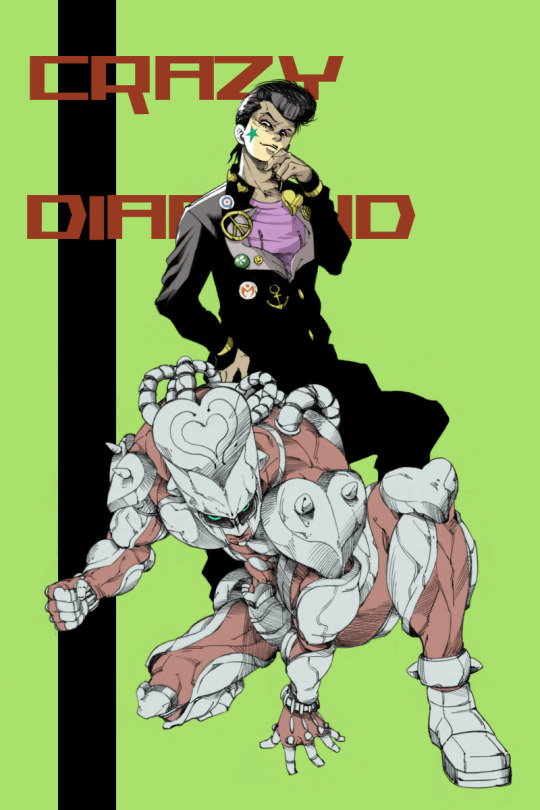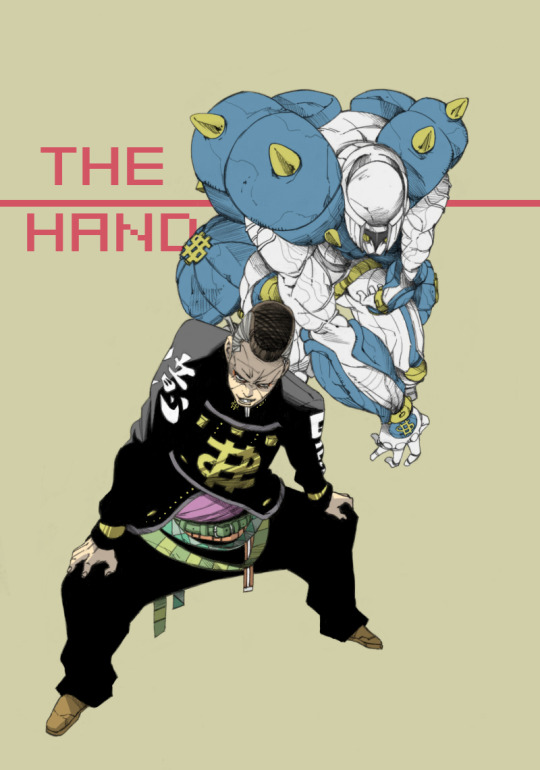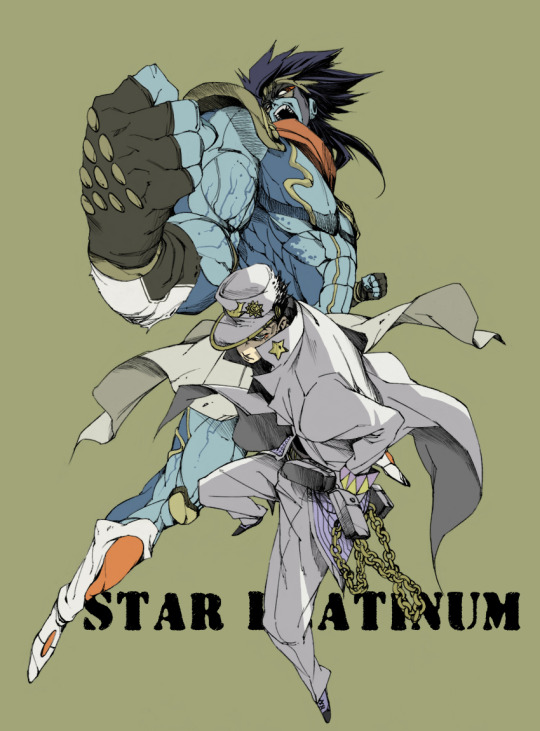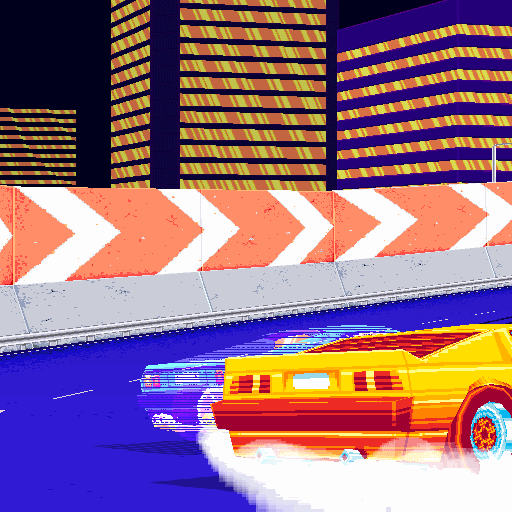Text
Iron Blooded Orphans broke my heart [SPOILERS]
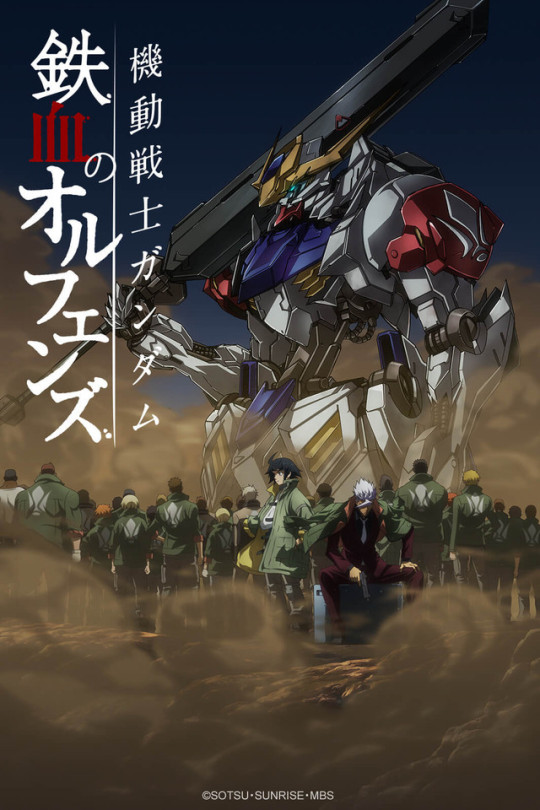
I finished all of Mobile Suit Gundam: Iron Blooded Orphans last night, but the show I once loved made me feel hollow and unsatisfied.
I quickly fell in love with IBO and that feeling persisted through the whole first season. The journey of Tekkadan from Mars to Earth, and that amazing conclusion in Edmonton had marked it solidly as one of my all time favorite Gundam series ever. The strength of IBO to me was it's characters and world building. I was invested in the group of kids taking control of the private military company CGS to help fight for the betterment of their lives while forging deep family bonds. While most of the members of Tekkadan didn't get all that much screen time, I really enjoyed the personalities of the primary characters. Mikazuki and Orga's longtime, co-dependent relationship was really compelling, you could really feel the longtime emotional bonds between them. Kudelia's lofty goal of independence for Mars, combined with Tekkadan's underdog nature made it a group I was really engaged with and emotionally invested in. The antagonists weren't the most compelling, but the dynamic between McGillis, Gaelio, and Carta gave the opposing side some more depth beyond their immediate goals. You got a good sense of what each of those three Gjallarhorn officers were like as people. I also really enjoyed the political struggle of the series, the fight for independence from Earth is a common theme of Gundam, but I thought it was portrayed well here.
I deeply loved this show throughout all of the first season, but the direction taken in season 2 slowly beat me down until I could no longer pretend I was enjoying it. The last four episodes really kicked the wind out of my sails and felt cheap. IBO season 1 had one focused plotline that made sense and felt cohesive all the way through. Season 2 is a bunch of loosely connected mini-arcs with no clear focus, vision, or message. The way character death is handled in this season is one of main reason why I'm upset. It's not just because almost all of the primary characters are killed off, it's the way in which it occurs and the way the epilogue plays out. It doesn't lead to, or accomplish, anything. The ending feels stolen from the characters in a really sick way.
Biscuit's death in the first season had a ton of build up, and we really got to know him as a person and learn about him through his relationships to Orga and the crew. His death informed the decisions and actions of Tekkadan in a meaningful way. In season 2, it felt like the writers just wanted to kill everyone to seem sad or intense, but it doesn't work. By the time Mikazuki and Akihiro are killed in the final episode, I was numb to impact of their death. I didn't feel sad because of their circumstance, I felt sad that the writers drew out this whole series of characters deaths to the point where it felt formulaic and predictable. The deaths of Naze, Amida, and Lafter was unnecessary but drove the plot forward by having Tekkadan take revenge of Jasley Donomikols, which ultimately led to nothing.
Shino, Orga, McGillis, Hush, Akihiro, Mika. They all die losing. Tekkadan utterly loses, but is able to protect the lives of the rest of their crew. If through their sacrifice they were able to create the positive future for their friends, that would be one thing. But they don't and Gjallarhorn wins. Julieta holds the Gundam Barbatos' head on her sword triumphantly, and Rustal Elion maintains his power and influence through successful corruption, controlling the media message on the truth of Tekkadan and McGillis.
The loss and following epilogue really made me angry as I watched. For some reason, despite being shown to be a corrupt leader who crushes everything in his path, Rustal Elion decides to dismantle the Seven Stars system of leadership in Gjallarhorn and reform it as a democratic organization (he, of course, is elected to be it's first leader). Rustal lets Kudelia becomes the chairperson of the newly independent Mars Union and works with her to abolish Human Debris (slave) trafficking. The antagonist won and through his power let the rest of Tekkadan live, all knowing that he unnecessarily killed their friends and tarnished their names as a scapegoat to punish McGillis. The only reason they still live is because of Rustal and they just have to accept it. It's embarrassing and degrading. Yet, everyone seems fine with that (with the obvious exception of Ride).
Watching the epilogue made me to realize that much of the character work throughout the series really didn't make much sense. Rustal Elion specifically. As the main antagonist of the series, we know nothing about him or his ideals. We only see him act as a mustache twirling villain throughout the whole series, but for some reason he ends up enacting McGillis' idea of reforming Gjallarhorn. We have no reason as to why he has done this. It feels really unearned and like a desperate attempt to make a comment about there not being a difference between good and evil, just different pathways for change. This explanation feels extra hollow because the whole show absolutely depicted the different factions as good and evil.
Julieta and Gaelio's ending was ridiculous as well. These two awful characters get a "Let's go eat meat! Anime! lol XD" ending after a whole season of being half-baked uninteresting grunts. Julieta in particular has no character at all. "I need to get stronger" to the ultimate cliche degree. She is a consistently annoying presence that has almost no connections to other characters and offers nothing meaningful to the story through the entire season. While Gaelio wants his revenge against McGillis, their confrontation ends in a rather anticlimactic showdown. Iok Kujan is a ridiculous cartoon clown that only exists to ruin everything. His presence actively made the show worse at every turn.
McGillis' mysterious intentions were interesting in season 1 but once he started to realize his plans, and they started to blow up in his face immediately, he showed no signs of recognizing his failure and this rapid loss of control. McGillis was a frustrating idiot to watch every time he was on screen, an incompetent Char clone. We never really knew what his plan to reform Gjallarhorn was all about outside of removing the corruption from within. But as soon as he got his hands on Gundam Bael, he demanded that the entire organization follow his every order like a dictator. He didn't use his platform to expose corruption, he used it to gain power and forgot everything that led him to that point. He had no plan to counter Rustal, who was obviously going to oppose him. The show wants to portray him has some sort of scheming puppet master, but the writing consistently fails to demonstrate this in any way. Why is Bael some sort of icon of leadership? Why does McGillis think that as soon in as he pilots it everyone will obey him somehow?
With such a large focus on the Gjallarhorn side of things this season you would think we would get some sort of new insight as to the ideology or internal conflicts of the organization, but that doesn't happen. Everything presented is so shallow. Also the entire character of Almiria goes absolutely nowhere.
Tekkadan also saw some new recruits join the team this season, but they remain underdeveloped hangers-on in most cases. Hush, the most prominent of the new recruits, gets almost nothing to do and his relationship to Mika is not well developed at all. His death felt like it should have had a strong emotional impact, but because he was so underdeveloped I felt nothing. He didn't have that much interaction with the other characters this season, spending most of his screen time as Mika's assistant. He says he wants to learn from Mika, but we almost never see the two of them talk. We never get a chance to care for him or understand what he adds to the group dynamic.
The treatment of Atra and Kudelia was awful. In season 2, they are given nothing to do aside from fawn over Mika. Because it's not anime unless every woman in the show is somehow in love with our antisocial, quiet protagonist boy. Atra and Kudelia are most often seen talking to each other, and it is always about Mika. They only ever talk about him and about loving him. This does a real disservice to the characters who had so much potential. As the Founder/President of the Admoss company Kudelia could have been playing politics to help Tekkadan through the entire season. Atra could have actually helped out with the Tekkadan crew in person and had her own independent goals. Kudelia’s love for Mika was not convincing at all to me. Atra has the benefit of knowing him for most of her life and their relationship goes back the longest outside of Mika and Orga. Their romance wasn’t too out of place. But I don’t think IBO ever made a convincing case for Kudelia’s love for Mikazuki outside of his role as the “main character.” I think Mika and Atra having a baby and Kudelia becoming the step-mom after Mika’s death is a cool idea on paper, but it’s execution in the show was brutal to watch.
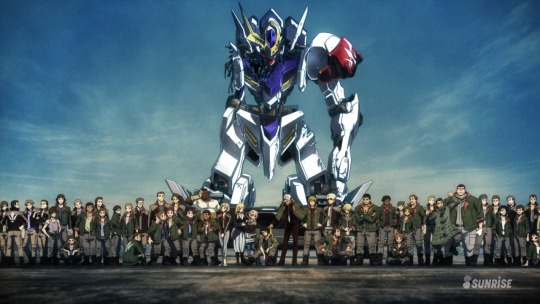
Season 2 felt like the writers did not know where to take the story so they threw everything they had on the page. It resulted in a muddled mess of themes and story lines with not enough time to give any characters their due. None of the deaths made much of an impact on the main crew at all. Everyone got over each death extremely quickly. You get one scene of brooding then you move on.
There is a part of me that's just angry about seeing characters I liked die, but it only serves to back up my opinion that death is often a lame way to create drama. The removal of a character is not interesting. You are eliminating a person from your story that (hopefully) had relationships, motivations, goals, and hopes. The interactions between your characters is what gives depth to your story and shows how they each grow individually and as a group. Removing all the characters removes possibility. You can show pain and suffering in other ways. Killing off almost every single one of the primary characters was a boring move.
And it makes me sad.
#gundam#iron blooded orphans#mikazuki augus#orga itsuka#kudelia aina bernstein#atra mixta#mcgillis fareed#anime#anime review#review#sunrise#crunchyroll#mobile suit gundam#spoiler#spoilers
89 notes
·
View notes
Photo


The Sonic CD FMV from the original Sega CD didn’t have all the animation and color you’ve come to know nowadays. Here’s the low resolution animation of Stardust Speedway Zone from the ending.
[Sonic The Hedgeblog]
[Support us on Patreon]
5K notes
·
View notes
Text
Breath of the Wild final impressions
As I watched the credits roll on Breath of the Wild I was conflicted. The game had been a ton of fun, a fresh new take on the series while also being a great open-world game in its own right. But despite enjoying my time with it, I ultimately felt very dissapointed.
Breath of the Wild is not a bad game, far from it, but I couldn’t shake the feeling that I didn’t get what I wanted. In their quest to mix up the “Zelda formula” and bring a new structure to the series, the developers left too much behind. Resulting in a good, but ultimately unfulfilling game.

Ask any fan of the series what their favorite entry is and you’ll get a different answer every time. The draw and appeal of Zelda is so varied that fans often disagree as to what elements are most valuable to them. One of the biggest draws for me has been the design of the dungeons themselves. It’s not just about the individual puzzles in each room, but the way these puzzle rooms are connected to make the dungeon a puzzle itself. Zelda dungeons are at their best when they require the player to understand the architecture and mechanics of the space and make it fun to unravel both the individual puzzles and the overall dungeon itself.
For a deeper examination of the way Nintendo designs these structures, I highly recommend watching Mark Brown’s Boss Keys youtube series. Brown talks about each game in the series and analyzes the way dungeons are designed. This series was very influential for me and helped solidify my thoughts on this topic. I recommend the Majora’s Mask video as it perfectly explains why I love that game.
With BotW, Nintendo very clearly targeted the strengths and design values of the very first entry in the series. An open space where the player has agency to make their own decisions about where to go and what to do. With no predetermined narrative-based path, you can do what you want, when you want. However, in achieving this goal, the pacing and tight design of the Zelda series is mostly pushed aside in favor of player freedom.
Without a strong narrative path, the developers used the shrines as an incentive for players to explore. The 120 shrines mostly use the game mechanics and player abilities very well, but were also responsible for 120 moments of stinging disappointment. Every time I finished one, I felt unsatisfied because it was just one puzzle unconnected to a greater scheme of interlocking rooms or challenges. While completing shrines I often thought about how much more I would have enjoyed the puzzle if it had been connected to the last 20 shrines I finished.
There are several combat challenge shrines, but they aren’t the most interesting or rewarding things to complete. Even the simple change of reducing the overall amount of shrines to make each one the equivalent of two puzzles and a combat room would have done wonders to the game. That change would make discovery and completion of the shrines more meaningful.
The overall quality of the shrines made the feeling even worse because with individual puzzles that strong, a solid, interconnected design would have probably lead to some of the best dungeons in the series.
The aesthetics of the shrines are all the same. The same music and visuals 120 times. I think that does a disservice to the variety of puzzles they feature, in addition to being boring after the first 20. Even simple themes like forest, ice, fire, wind, fortress, etc. would be a great way to mix up the visuals of these challenges.

Shrines at the beginning of the game look identical to shrines you will find many hours into your adventure.
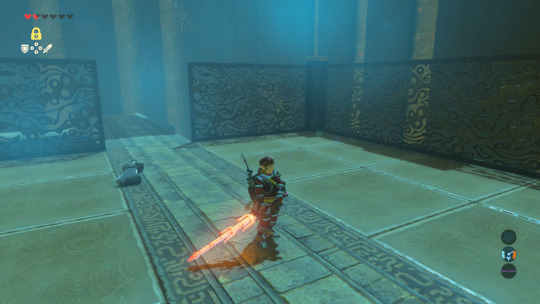
And then there are the Divine Beasts. They are the closest thing this game has to a traditional Zelda dungeon, because they are much larger than shrines, feature a short series of puzzles and end with a boss.
They share very little with the established "dungeon” forumla, but one aspect they do share with their predecessors is an important one, encouraging an understanding of the structure’s architecture. Each beast requires you to understand and manipulate the movement of the structure in order to activate five switches and fight a boss.The moving and twisting beats are impressive, but the actual goals within them leave a lot to be desired.
Not only are they much shorter than the dungeons of previous Zelda games, they all have the same objective of activating a few switches. Repeated objectives and simple physics puzzles get boring fast. After you complete one beast you have seen everything they can do.
None of the beasts provide the same feeling as a good Zelda dungeon, unraveling and fighting your way through a tightly wound knot of individual and interconnected puzzles rooms and gaining an understanding of the continuous layout of a piece of architecture. They are far too simple in their individual and overall puzzle design and feature very little combat, other than the bosses. Much like the shrines, the Divine Beasts are not bad, but they are a weak attempt at making sure something resembling a Zelda tradition remained in the game.
The beasts also have the same problem as the shrines in terms of aesthetics. They are all located in beautiful, distinct locations in the world, but the beasts themselves share the same theming (which isn’t very different from the shrines).
As someone who greatly values the traditional Zelda dungeon, this disappointment with BotW’s alternatives hit me hard. No one makes games like Zelda. No one makes Zelda-like dungeons. After waiting six years for the next 3D game in the series it sucks to be disappointed in this way.
It’s not just the dungeons, but the progression in complexity that I miss. The way the dungeon design builds from the Great Deku tree to the Spirit Temple in Ocarina of Time, or from Woodfall to Stone Tower Temple in Majora’s Mask is amazing. That hasn't been a part of Zelda in many years.
This was also one of my biggest problem with A Link Between Worlds. That game had traditional Zelda dungeons, but because the player could tackle them mostly out of order they all felt as if they were each designed to be the first dungeon. The game lost any sense of progression in complexity with dungeons that would be lucky if they lasted more than a couple minutes.
However, this game’s best moments are not the attempts to translate the dungeon format to a new structure. BotW’s strength is the open-world and sense of discovery. These were strongest for me in the first half of the game, when the majority of the world was a still a mystery.
Discovering shrines in the first half of the game was exciting, and solving the tiny Korok seed puzzles hidden throughout the world provided a unique distraction. The Korok seeds are so plentiful (900!) that you can always find enough to increase your inventory, but I felt that their implementation did more to help the developers fill up their massive world rather than create a good mechanic for the player. It’s just another meaningless collectible.
While exploration is incentivized by shrines and Korok seeds, the best discoveries were villages and towns. BotW has the best towns in any Zelda game hands down. They all have a unique atmosphere, great music, and are occupied by memorable NPCs that seem to run on a Majora’s Mask-like schedule. Discovering and entering Hateno Village at dawn was one of my all-time favorite video game moments.
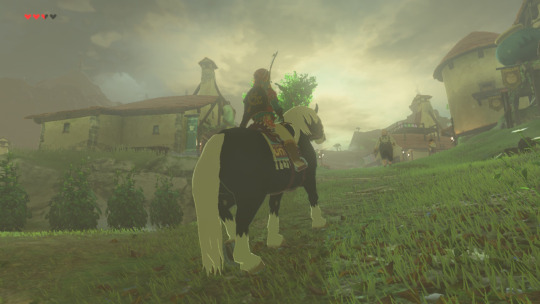
Once I had explored the world, found all the villages, and unlocked each section of the map, I realized that the only thing left to find were shrines and seeds. With Korok seeds cast aside as meaningless collectibles, looking for shrines quickly stopped being interesting as I knew the only thing I could find would only instill the same sense of longing for “real dungeons” that I had experienced dozens of times before.
Thankfully, many of the sidequests to find the shrines were some of the best moments of the game, taking the unique and interesting puzzles and bringing them onto the actual world map. But aside from those quests I did not find much fun in exploring the world. I wanted to avoid combat most of the time because I didn't want any of my weapons to break and the standard enemies often had worse gear than what I was carrying. Exploring for exploration’s sake does not interest me. I’ve never really been the kind of player that messes around in the open world games without a purpose.
The lack of enemy diversity throughout the world was very surprising. BotW has a strangely small variety of enemies. Zelda’s famous cast of monsters is mostly absent this time around as Link is left to fight standard and large sized Bokoblins and Lizalfos for most of the game. Fighting the same enemies over and over again started to bore me near the end of my playtime and I found it strange Nintendo left out so many different types monsters such as Like-Likes, Darknuts, Stalfos, Leevers, etc. It really doesn’t help the copy and pasted feel of many enemy encounters when the combat barely changes in hour one compared to hour 100.
I did like that they addressed the common complaint of combat difficulty. The enemies here actually put up a fight and provide for some tough encounters that require quick thinking and good reflexes. However, they also included two mechanics that trivialize the combat: Flurry Rush and parries.
Once I discovered how easy it is to abuse and activate the time slowing effects of Flurry Rush and parrying, the enemies were no longer a threat. The window to activate the Flurry Rush is so large that I often found myself triggering it when I wanted to back flip or sidestep for movement purposes.
The combat itself felt a little stiff as well. The way Link stops moving when he swings his sword felt abrupt and his canned combos felt too automated. When you attack, Link will perform a simple combo string. In past games, the direction and type of attack could vary depending on your input. Link’s moves would actually be based on player input. I missed the choice of horizontal and vertical slashes, a sword thrust, and a crouch stab from behind a shield, among other moves.
The runes were cool, but I did not use them very often during combat. The combat sandbox in general felt a little underwhelming, mostly because Stasis, Magnesis, and Cryonis are the only unique abilities Link gets.
The addition of infinite bombs seems like a carry over from ALBW’s item system, but don’t add much to the game. Infinite bombs are incredibly easy to abuse and are often more effective than arrows. I still think Wind Waker and the N64 games have the best combat sandboxes as they have a wide array of items and abilities without any overpowered dodges or parrying.
Because of the lack of unique items and abilities, the sense of progression is stunted. Link doesn’t gain access to new areas with the acquisition of tools that allows him to interact with the world and enemies in a different way. You get your rune abilities at the beginning and that is it. You are stuck making water platforms and moving metal objects for the rest of the game. I’ve always felt Zelda was better off closer to the Metroidvania style of design than an open world style, and BotW only reaffirms that opinion. BotW loses the moments of realization that your newly acquired abilities/items/information can be used in an earlier area to access something new, or recontextualize something you thought you had a handle on.
Link’s various armor sets also exemplify the grindy nature of this open world by requiring you to farm items to upgrade equipment. This is probably the most standard open world aspect of the game and one that is just not worth engaging in.
I also wanted to touch on the story and characters, which is another element that I feel is important to the series (even if many disagree). Because of the open design, the story was pushed out of the players way for the most part. Unfortunately this led to a bunch of underdeveloped characters I never cared about. The hints into each Champion’s history and relationships with other characters was intriguing, but we never got anything more than simple archetypes. It would have been great to see longer story quests build up to the divine beasts.
One of the biggest story fumbles were the memories. While some were interesting they often added so little and often felt pointless. They gave us scraps of characterization for Zelda and that’s it. As for timeline stuff, the game is so vague that it doesn’t really matter (and I’m a Zelda timeline lover).
There are no memorable characters. We get interactions between the various champions and Zelda in flashbacks, but learn almost nothing about them, their personal histories, or see them grow or change in any meaningful way.
Games like Wind Waker and Majora’s Mask have you meet characters that have arcs, relationships, and goals. Players watch the characters grow and change. They inform the plot while growing along with the overall narrative. You see each character receive closure to their own storylines alongside the main narrative.
There is no plot in BotW. You wake up and are told to kill Ganon. If you defeat the Divine Beats you get to see more of Link’s lost memory, but all of that happened in the past, and you know that the four primary characters are already dead. Their fate is known before the player is even introduced to them.
There is no sense of urgency or danger. In Majora’s Mask you can see how Skull Kid’s meddling and the threat of the falling moon have negatively impacted every single one of the residents of Termina. The Deku Swamp’s water has been poisoned, the Gorons are frozen over, the sea temperature has risen and Lulu’s eggs Zora eggs have been stolen by pirates, the Ikana researcher has been turned into a zombie and the land has been cursed to keep the undead from dying completely. In Breath of the Wild, none of the people are in any danger. No one is scared of the obvious and inevitable return of Ganon. After the calamity life went on, the fall of an entire civilization didn’t seem to have much of an effect on the existing citizenry of Hyrule.

For a series that receives such massive amounts of praise, I don’t think Nintendo can keep on barely scraping by in the story and lore department. Nintendo should put more time and effort into a stronger focus on the narrative for this series. It’s a shame when the peak of storytelling in your franchise was over a decade ago (even though Majora’s Mask and Wind Waker were great).
I enjoyed my time with BotW immensely in the first 20 to 30 hours, but once I had a consistent understanding of the world and mechanics, I started to pick apart all the little things that I didn’t like, and it really hurt my enjoyment of the game.
What makes it hard for me is reading other Zelda fans’ impressions stating this is the best game in the series and that they hope Zelda never goes back to the way it was before. This series can and has done more. It has provided interesting worlds, memorable characters, unique and inventive puzzles and challenges that have stayed with me for years. When I think of BotW I just remember all of the things I didn’t like. I just think about how I can’t see myself ever returning to this game in the same way I do to almost every other game in the series.
It makes me sad because the traditional, more linear Zelda formula, despite some bad design decisions in the later games, still provides a valuable experience and is responsible for more than a handful of my favorite video games of all time.
DLC UPDATE: I really liked the Champion’s Ballad DLC just because of the shrine and Divine Beast. The new shrines were some of the best in the game, and the new divine beast was by far the best. The boss at the end was a unique challenge and is one of my favorite moments in BotW, it felt like an important event in a way that almost nothing else did in the base game.
#the legend of zelda#zelda#link#nintendo#nintendo switch#wii u#nintendo wii u#kass#urbosa#mipha#daruk#revali#open world#ocarina of time#majora's mask#wind waker
6 notes
·
View notes
Text
The reaction to a gender option in Zelda is sad
This past week some details about the upcoming Legend of Zelda game were leaked by a well known individual. Due to the circumstances around the leaker and past leaks, most people believe these to be true. However, the second of the three details has lead to some disagreement within the fanbase that I want to address.
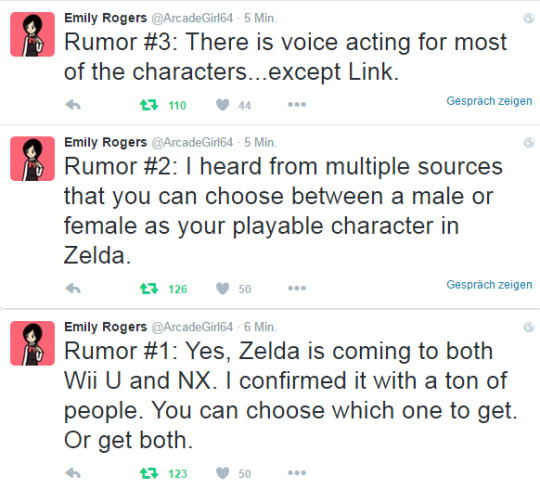
Some fans don’t like that Link could be a girl, or have a gender option at all. The general argument against this is that Link is an established character like Mario, Samus, Snake, etc. and being able to change gender would somehow ruin the character. Others ask “why can’t we just play as Zelda?”
There are many theories about this gender choice that I‘ve read that could be cool in their own way. A choice between Link and Zelda as playable characters or Link and a new character. I think those ideas would be interesting, but I’m more bewildered by the disgust that I have seen from people online about the prospect that Link could be a woman.
The obvious counter argument is that Link is not an established character, but rather an established concept. The actual role of Link has been filled by completely different individuals from different time periods. As long as the upcoming entry isn’t a direct sequel to a previous game, then the development team can do whatever they want with the character and still have it be Link.
In Hyrule Warriors, the character Linkle was introduced as a female Link type character. She is not Link, but a similar character. Some have suggested that Linkle, or another similar yet separate character should be the playable character but I think that misses the point of a gender toggle and only further illustrates some people’s aversion to the concept of a female Link.
To a lot of people Link represents a set of traits that are shared from reincarnation to reincarnation. They seem to include his gender as one of those traits.
Link is the embodiment of courage, perseverance, determination, and hard work. None of that is exclusive to men. Link has been many people and they do share characteristics and personalities, but none of their traits have ever involved their gender and to insinuate otherwise is absolutely ridiculous.
The fact is that there are a ton of people who want to see representation of who they are in media, but unless you are a white guy you probably aren’t going to get much. The complaints, mostly from white guys on the internet, act as if the choice to be a female Link would somehow take away from the male option despite it being just an option.
It really comes off as a bunch of little boys climbing into their treehouse and hanging up a sign that reads “NO GIRLS ALLOWED.”
Here are some posts from the GAF thread that I particularly liked.
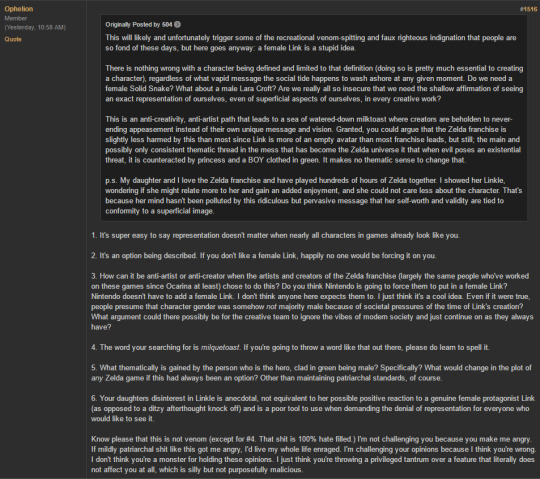

4 notes
·
View notes
Text
Xenoblade X review/impressions
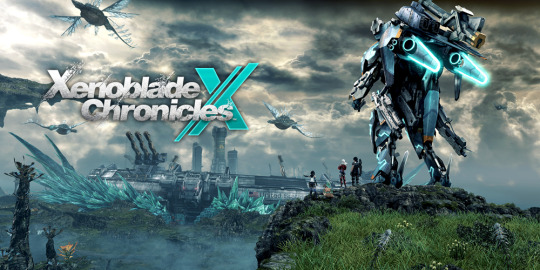
I’m going to be making a lot of comparisons to the first Xenoblade game in this review/impressions/analysis post as it is my closest reference to this style of game. I don’t play MMOs so this whole single-player MMO type genre is foreign to me outside of the Xenoblade series. I’m also going to try and be as spoiler free as possible.
I adored the first Xenoblade. I didn’t play it when it was first released in North America, but I bought a copy knowing that one day I would check it out. That day came in late 2014 as I was finishing up with school and getting my degree. I ended up playing the game on my PC through the Dolphin emulator. Being able to play in a significantly higher resolution (3x native resolution at 1920x1584) than the game was intended for definitely made the experience a lot easier to get into since running it at 480p on an HD TV makes it look really terrible. The game itself was really fun, deep enough to keep you occupied for 80 hours but it never felt too overwhelming and explained itself well. It had a relatively linear structure but progressed through massive environments that let you explore and the story it told, while not exactly revolutionary, had surprisingly fantastic acting and really engaging story beats. Of course the music deserves a mention as it has one of the all-time great JRPG soundtracks (thanks to Yoko Shimomura, ACE+, Manami Kiyouta, and Yasunori Mitsuda).
When Xenoblade X was announced I was very excited, and after playing the first game my excitement had only grown. But as more information was released it was clear that XBX was going to be very different from its predecessor. After having played it I am left with mixed emotions.
Xenoblade X, despite taking nearly 100 hours to complete, feels like the beginning of a more important game. For all of its amazing elements, of which there are many, XBX is not able to achieve all it sets out to do and ultimately ends as an inferior version of its predecessor.
There is so much to unpack here, but I’ll start where everyone starts, the beginning.
Earth is destroyed in a war between two alien forces. Seemingly caught in the crossfire, humanity is forced to escape the planet on massive ships designed to act as arks. On them are the last remaining people, animals, and information of human civilization. The White Whale, a human ship, escapes Earth before the planet’s destruction and crash lands on a planet they call Mira. From there humanity is forced to redevelop their infrastructure and find the pieces of the Lifehold, a chunk of the ship that is vital to their survival, before their resources completely run out.
The game opens by having you create a character. This is already a massive departure from Xenoblade which featured Shulk as the main protagonist. Shulk was a character with history, relationships, likes and dislikes, and a personality. Moving to a mute protagonist is a tough switch and says a lot about the direction Monolithsoft went when designing XBX. Tetsya Takahashi, director of XBX and president of Monolithsoft, has said he has been inspired by open world WRPGs and it shows especially in this regard. However, the implementation of ideas seen more commonly in WRPGs can be weak. The main problem with this choice is that in WRPGs when a create-a-character is used the game is usually designed to let you make story decisions. With XBX, your character has literally no influence on any decisions and does not interact with any characters in any meaningful way besides participating in combat. The game will stop cutscenes and give you a choice between two actions but they have absolutely no meaningful impact regarding story and will occasionally earn you some affinity points from certain characters.
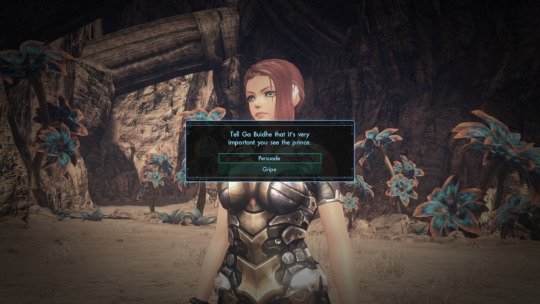
The supporting cast, which build affinity points from actions like dialogue choices, are thin at best. You can have a maximum of 4 party members (including yourself) at any given time but the game forces you to use Elma and Lin, the two most prominent characters in the game (and the real protagonists), for large portions of the story missions. This means that you are left to fill one remaining spot. The problem is that the game never develops any of these other characters in meaningful ways. Most of the character development happens in affinity missions which act as side stories that let you learn more about the world and characters. This would be great if the affinity missions told any interesting stories, but between helping a guy stalk a woman and buy her expensive gifts and finding another soldier’s lost cat, compelling stories are something that XBX doesn’t have a lot of.
Thankfully the main scenario is much more interesting, but ends as soon as it starts to pick up. The story is very poorly paced with the large majority of plot happening in the final two missions. The game is so back loaded with narrative that it feels like you’ve started playing a different game. Characters have unclear connections, antagonists monologue very vaguely about their true intentions, factions shift allegiances, and it all ends with a massive cliffhanger. There are multiple antagonists that are built up as very important and they just stop appearing completely, as if they just decided to take the day off. It’s bizarre.
The strange layer on top of all this is the audio mixing in the cutscenes. The voices are relatively quiet compared to the extremely loud and often obnoxious soundtrack. This leads to really awkward scenarios where characters are explaining really boring mission details while the dramatic music drowns out their dialogue. If I didn’t have subtitles on I would have missed a lot of what the characters were saying. The most bizarre example of this was a scene where two generic office men in suits had their dialogue drowned out by a super loud J-Rock song.
When the credits were rolling I couldn’t help but feel as though the story presented in the game was just the first act of a much larger plot. The story in those last two missions is very interesting and works pretty well, which is why the game left me so unsatisfied. I had just played 80 hours of a game only to get the first semblance of interesting story at the very end.
The music is also another aspect I am mixed on. Hiroyuki Sawano, XBX’s composer, is one of those musicians that is either hated or loved. If you already dislike Sawano’s other compositions for games and anime you are not going to have your opinion changed. Personally I am mixed on Sawano, I think a lot of his music is very good, but his consistently poor use of vocals is very annoying. Vocals on a Sawano track have an 85% chance of ruining the song. The problem is that the main hub city where you spend hours and hours of time is also home to the worst vocal tracks in the entire game. It’s beyond bad.
The rest of the soundtrack is quite good, with really fantastic instrumental pieces for the day and night themes of the various continents. Outside of vocals, the biggest element of the music that stands out is… well… it doesn’t stand out. It sounds like every other Sawano OST in any random anime. This is probably the composer’s biggest issue. The first Xenoblade had an extremely memorable soundtrack done by a group of really fantastic composers. There was a variety there that gave the game a personality. It didn’t sound like anything else. XBX’s problem is that it sounds exactly like everything else the composer has done.
Fortunately, the game itself is very fun. Building off the base of the first game, Xenoblade X’s base battle system remains largely unchanged. It’s pretty much just an MMO. You have an auto attack that builds up a special meter and a set of arts that go into a cooldown state once used. Many of the arts require you be behind or to the side of your opponent, which makes movement and positions important in battle and can drastically change how you fight depending on the environment. Exploring the massive world, discovering new locations and monsters, and finding treasure kept me occupied for a long time.
The sense of exploration is really promoted by the fantastic level design of the five continents. Exploration isn’t as easy as picking a point on the screen to run to. You have to learn the layout and geography of the region and know what kind of enemies are guarding certain pathways. Running through an area full of creatures much stronger than you is really tense. The thrill of going through an area you don’t feel you should be at yet is part of what drove me to keep exploring.
All of these elements work really well together but the systems that surround combat, specifically classes, left me unsatisfied.

In the first Xenoblade each of the seven characters had very specific roles they would fill. Tank, DPS, Healer, buff/debuffs, etc. Not only that but each of the characters had a well-designed personality around that played into their combat role. If you wanted to change up your strategy you would have to change up your team composition. You always knew what each character was doing at any given time during a fight and you could feel their influence in battle. This made each character feel like they had an important role in the party and were vital to the core of the story. This melding of mechanics and narrative made the characters memorable for more than just narrative reasons and gave Xenoblade a feeling of cohesion that is missing in most JRPGs.
In XBX every class feels completely inconsequential. I jumped around from class to class throughout the whole game but never felt like I was truly playing a unique role. The arts felt only slightly different with the different weapons governing my auto attacks. I also never knew what my party members were doing. Their actions felt completely irrelevant to the battle. The only thing I felt my party members contributed to was calling out Soul Voice lines in order for me to respond and heal my party. My fourth slot could be filled by any of the poorly-developed, barely-present side characters and nothing would change. Changing up party members to execute on different strategies is pointless.
The problems with classes only increase once you get a Skell. Classes have no impact on Skell abilities at all. Once you are able to ride around in your giant mech you never want to leave, making classes even more irrelevant. They have a small range of abilities and skills that are determined by a few types of equipment. Not much to differentiate each other or have them play different roles in battle.

While I’m on the topic of Skells, the way the change the game is very interesting. In most JRPGs you start in a small location only to eventually find yourself in a world that is bigger than anything you have seen so far. In XBX, getting a Skell actually makes Mira feel much smaller. Previous areas that felt massive and mysterious are revealed to be simple locations hiding nothing but a couple of strong enemies.
On one hand, riding in a Skell gives you a sense of power that just wasn’t there in the first half of the game. On the other, the world feels so small and lacking in interesting activities that the impressively large world is loses its luster. This feeling is only increased tenfold once you gain the ability to fly. New areas are opened to you, but are small and don’t have much interesting going on. Flying also eliminates your need to go anywhere on foot, preventing you from interacting with and navigating through the environment. I can’t think of another game that actively eliminates its level design like this.
Skell insurance is also an incredibly bizarre mechanic that doesn’t add anything and didn’t need to be there. When you buy a Skell you have three insurance points. When your Skell is destroyed in battle you get to do a quicktime event to save it. If you land a “Perfect” your Skell is repaired at no cost. If you get a “Good” or miss the prompt entirely you lose one insurance point. When you are at zero you have to either get a salvage ticket through the faction reward terminal or pay a hefty fee. This mechanic is pointless. Skells already cost insane amounts of money and the fee to repair them is almost as much as buying a level 30 Skell. I really don’t see any point to this other than an unnecessary waste of time and money. This just makes the player want to stay away from tough fights.
I also want discuss is gear. I’m not sure I fully understand the purpose of gear and why most of it is gated behind certain level requirements. I had some arm equipment I got in the first 10 hours that was never replaced throughout my 80 hours playtime because nothing was better. I was scrolling through level 50 gear and none of the pieces of equipment had better stats than what I was using. I’m left with a feeling of confusion. I didn’t have to spend money on gear, but I never really felt like my character was progressing and getting stronger outside of just leveling up. I know gear has augment slots and I can only imagine that augments really come into play once you start fighting the post-game super bosses, but I never had to use or worry about those.
The last thing I want to touch on are the menus and UI, which are awful. Almost every menu has commands that are not explained or have any onscreen representation. The arts menu allows you to equip and upgrade your skills. However there is no onscreen prompt to upgrade your arts. You just press X and the upgrade menu is brought up. These “hidden” menu commands are in almost every important menu that the player will be using. This is just another bizarre design decision.

While Xenoblade Chronicles X is a good game, I had so many problems with it that it ended up really effecting my enjoyment overall. While I don’t think there are any huge flaws, the game has so many little ones that they start to outweigh the positives. All of the best games have flaws, but the good elements work so well together that they overshadow the bad. Xenoblade Chronicles X is not one of those games.
2 notes
·
View notes
Photo
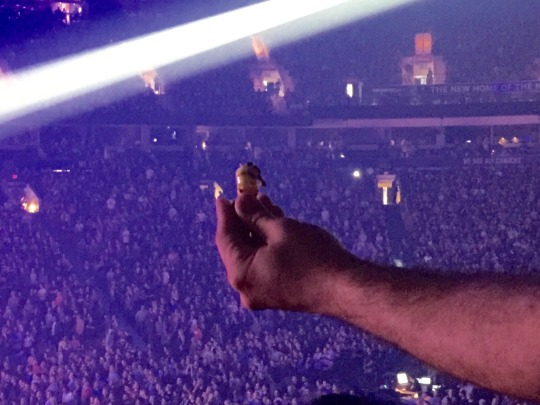
This dude sitting next to me at the Rush concert was taking MINION SELFIES during the show. What the hell…
8 notes
·
View notes
Text
Spider Gwen Issue #1 Review (aka my first entry into American comics)
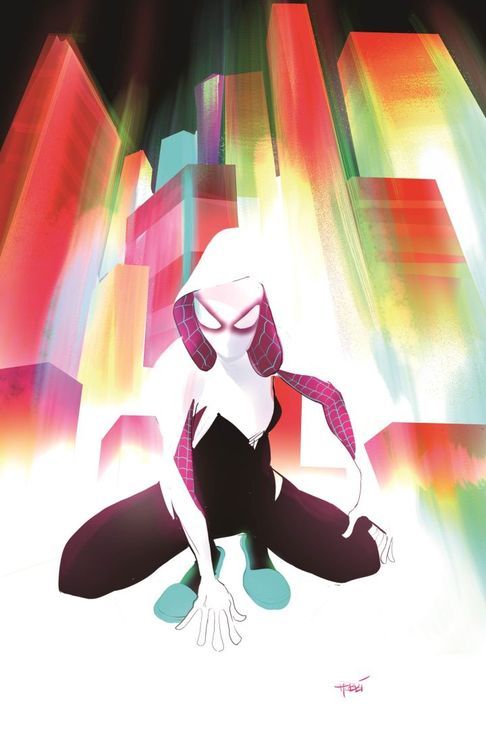
I’m not really into comic books. I’ve seen the movies and friends have explained the various stories and characters to me, but I’ve never been interested enough to start reading until recently. As a teenager, I really got into Anime and Manga as my interest in Japanese entertainment shifted from just video games, to TV and comics as well. There is a lot of crossover between American and Japanese comic fans but I never really ventured in the iconic super hero stable of Marvel and DC. Their reputations painted them as obtuse and hard to get into, with over-complicated plots and storylines flowing from one universe into another and back again. This reputation of complexity turned me off, especially because I was so used to the Manga style of one story being told in one series and that’s it.
I recently decided to take the plunge with this new run of Spider-Gwen.
A friend showed me this new “Spider-Gwen” design and told me a bit about the background of the story. I thought the costume design was amazing and the art looked really cool so I decided to jump in and read comics for the first time.

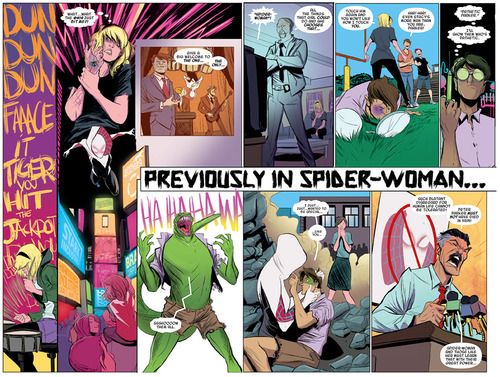
I was told to start with “Edge of the Spider-Verse #2” as it contained Gwen’s first appearance. What I didn’t expect was a big “Previously in Spider-Woman…” page quickly skipping through the details and first story arc of our hero. Did I miss something? Is there another issue that I should be reading first? Well… no. After looking around online I found out that this was meant to act as a quick look into the middle of this characters story. In fact, that “previously in…” page has never actually happened. It is a reference to a story that doesn’t exist. So I’m 2 pages in and confused already, not a good sign.
The rest of the issue works quite well. I thought it sets up Gwen, her friends and the struggle with her father and the police in an engaging way. After a big fight with a villain in a club, Spider-Gwen is confronted by her father at gunpoint as he attempts to arrest her. It is then that she takes off her mask and reveals herself to be his daughter. I was really surprised they pulled this card in the very first issue of this character's appearance. At first I thought it was stupid that they just used up that whole “concealed identity/having to lead two lives” plot, but now I think they may have done that to introduce new types of conflict for the character. Getting rid of a cliche to try and do something new? Awesome.
“Edge of the Spider-Verse #2” ends with Spider-UK hiding in the rafters watching all of the events play out. In big text the panel states that “Gwen Stacy will return in The Amazing Spider-Man #9”. What? I haven’t even gotten to Spider-Gwen #1 yet and we already have a storyline going through three different series? Ugh, now I remember why comics have a reputation for being confusing to follow.
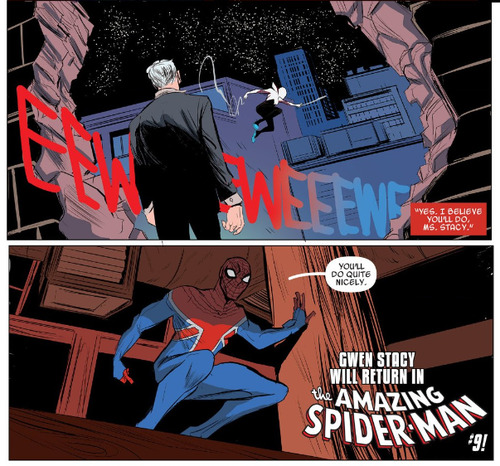
Well alright, let’s keep going. I was told that after I read “Edge of the Spider-Verse #2” I could start "Spider-Gwen #1”. Cool. But wait… didn't the last page say that the story would continue in ASM #9? Well whatever, I’ll just keep reading what I've got.
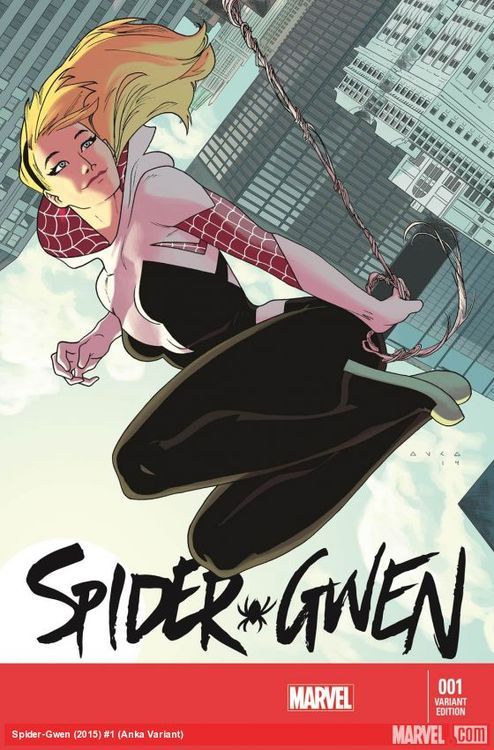
Spider-Gwen’s first page is a recap of both the origin story that has still never been told and EotSV #2. Well… off to a great start I see. The first page shows Gwen taking off her mask and her father’s reaction. If I picked up Spider-Gwen #1 thinking I was getting the beginning of a story I would be really confused.
The issue starts off with some kids vandalizing an anti-Spider-Woman billboard and The Vulture is introduced. I think it works well as an introduction to the world as well as an exciting way to introduce a threat. We cut to Gwen fighting the Bodega Bandit in an alley as she remarks that she just got back from “fighting in a war for the fate of all reality”. Ok stop. What the hell is going on here? This panel also has an editor’s note to “see spider-verse”. Uh, I did. I read the spider verse issue where she was introduced. It is at this point that I put together that the spider-verse storyline that was supposed to continue in ASM #9 must have continued and concluded before Spider-Women #1 takes place.

This is really frustrating. I wanted to read this new and interesting take on Spider-Man but instead I’m dumped in the middle of story with characters I don’t know and history and motivations I’m unaware of. Not only are we left without a proper introduction to the character, but we don’t have an origin story, first story arc, second story arc, and possibly more before the start of the “first” issue. We don't even have any indication as to what issues you should read if you want to find out more about her story.
I feel now like I’ve missed so much of the plot that, while what I’m reading is enjoyable, that nagging feeling like I’m missing something is severely damaging my enjoyment of the story in front of me.
The whole time I am constantly comparing this introduction and story structure to other Manga series I have read. If you wanted to know the story of Joesph Joestar you start reading JoJo’s Bizarre Adventure: Battle Tendency from the first issue. If you wanted to know the story of the Elric Brothers you start reading Full Metal Alchemist from issue #1. In the case of FMA, it doesn’t even start with an origin story, these characters are already set and the origin is told later on, but you know that the story is meant to be told on the way. It is all one series and is told in a specific order. This bizarre introduction of Gwen and her world over who knows how many different comic series is frustrating and confusing.
Spider Gwen just doesn't work as an intro to the character. Edge of the Spider-Verse #2 however, is much closer to what we should have got.
EofSV #2 did a good job of introducing the character, but its opening was very confusing and gave us half-formed details that we really didn't need to know. If you imagine the issue without that page, the intro works a lot better. We are introduced to our protagonist and her band having trouble practicing while something is clearly bothering Gwen. We then shift to Gwen sitting atop a billboard thinking about Peter Parker while saying things like "All these things I can't say", "He'll never know" and "I- I'm sorry Peter...". Without that "previously on" page, this scene is given a sense of mystery to it that feels really engaging. The reader has to ask where Peter is. Whats going on between them? Is he okay? If she has spider powers then what is going on with him? All of these inquiries help bring us closer to this character. When we eventually find out that Peter has died and Spider-Woman is thought to be his murderer, the reveal has a strong impact. The way it was presented now is so weak that the reader's reaction is something along the lines of "huh, that was weird."
I really do like what I’ve read so far and want to continue reading this series, but I’m going to track down what happened in between EotSV and SG because I need to know what exactly is going on with this character. I would just like it more if I didn’t have to do detective work to find out.
Update: I’ve found that the Spider-Verse storyline is told across seven different series:
Edge of the Spider-Verse
Superior Spider-Man
Amazing Spider-Man
Spider-Verse Team-Up
Spider-Verse
Spider-Woman
Scarlet Spiders
Welp…
#spider gwen#gwen stacy#marvel#marvel comics#review#spidergwen#spiderwoman#spider woman#spiderverse#peter parker#comics#confusion#manga#anime#jojo's bizarre adventure#full metal alchemist
1 note
·
View note
Text
Majora's Mask 3D Review/Impressions

Okay so I just finished up Majora’s Mask 3D (fair warning: I’m going to be very nitpicky because this game is really great and there isn’t a lot to praise that hasn’t been praised already). Going into it I was really disappointed by all of the changes I had seen up to that point. However, by playing the game myself I found it to be much better than I was expecting. The biggest change to me was the saving system and my feelings on that haven’t changed. The new saving system negatively impacts the game design, atmosphere and tension. While that is a shame, I see now that it was an important change to better suit the game for a handheld system. It works perfectly for the platform it is on and really doesn’t make that much of a difference. If this was a console remake I would not be as forgiving, but it works perfectly for the 3DS.
One of the biggest disappointments to me is that a lot of the changes make MM feel more “gamey” and break the feel of the world. Changes like the mask salesman giving you the Bombers’ notebook instead of the Bombers themselves. I get that they don’t want you to miss the notebook as it is very helpful to new players, but it doesn’t make any sense as to why he would have it. The bombers even say “If only you were human… Then I could give you an original Bombers’ Notebook and make you a member…” but they turn you away because you are a Deku Scrub. The player is meant to see that and remember to return once they become human again. This is meant to teach the player to pay attention and think about their quest options but this lesson is nullified by just giving it to you. This is just one example, but these more “gamey” changes also extend to the boss fights.
I really did not like the new boss fights. They have much more identifiable phases and have predicable “eye” weak points. The Odowala fight was fine, but the other 3 suffered. Goht just added an eye weak point to add a small, meaningless aspect to the fight and Gyorg’s fight has the standard “enemy sucks bomb” cliché. Twinmold is probably the worst offender. The giant’s mask is optional in the original version and it may not even occur to the player to use it during the fight. Even without the mask, Twinmold is still a doable, yet tough fight. The two Twinmolds are equal yet have different weaknesses and the player is left to decide how to take them on. In the 3DS version, the blue Twinmold is nothing more than a fodder enemy for the true fight against the red one. Giving you the Giant’s mask halfway through the boss fight felt really forced and becoming Donkey Kong Link to fight the boss was really silly in a way that just did not fit with the rest of the game. The stupid grab and swing animation didn’t help either.
One thing I really didn’t like was that movement and speed seemed to be universally slowed down. Deku Link’s spin no longer gives him a boost, the new Zora swimming is just awful and the Goron rolling is a switch instead of holding the button down. These aren’t big things, but I do think they take away a lot of the fun of just moving around, which is something I feel is never really talked about in games discussion (Nintendo has been doing this with Mario too, his movement has become slower and boring since SM64, but that’s a totally different discussion). This also extends to the first person view where using the circle pad is so slow that it’s almost unusable. Thank god for the amazing gyro aiming because using the first person view would be much harder without it.
Now a lot of my criticism is a bunch of nitpicky bullshit I know, but Majora’s Mask is my second favorite game ever and these types of things really stuck out to me as I know the original like the back of my hand. I think MM3D is a fantastic game and retains 99% of what I love about MM. My personal preference stays with the VC version, but MM3D is fantastic.
Majora's Mask 3D changes
These are the changes I noticed on my first playthrough.
General gameplay
Pictobox is now part of looking.
Save system revamp; owl statues are warp & save and feathers are save.
Deku link can only shoot at max charge but max charge does not pop.
Deku shot has reticule.
Deku spin does not give you a speed boost.
Quest items have their own section in the menu, giving items is easier.
Goron rolling: tap a to roll, tap again to unroll.
Bombers notebook: total revamp.
Song of double time: skip to any hour in the day.
Can skip song of soaring animation.
Song of soaring location moved to beginning of swamp.
Clock Town
South clock town is bigger.
Bank is in south clock, withdrawing and depositing is better. Withdraw starts at max count.
Two bombers members are in different locations
Game explicitly tells you to pop the balloon
Deku game gives you fishing pass.
Deku flower owner flies much faster.
Termina Field
Astral Observatory looks much better.
Garo mask looks completely different.
Southern Swamp
Deku guards no longer have vision range viewable at night
The bean cave is different shape, 2 lights one goes directly to bean patch.
Two stray fairies are in different places in woodfall.
Platforms in deku palace don't move until you land on them.
Bridge on upper level deku palace added fence so player doesn't fall off.
Great fairy gives double magic instead of red spin attack.
Some of the spiders in the swamp spider house are in different locations.
Snowhead
Goron cheif no longer hidden in snowball.
Bridge room in snowhead temple slight platform change.
Goht fight has "ramps" instead of bumps in the ground that act as ramps.
Obstacles appear on powder keg route.
Fence around entrance to snowhead temple.
Great Bay
Hole in the wall to drop to hookshot.
Magic pots along beaver racecourse.
Ikana Canyon
Invisible soldier moved to pirate hideout
Stone tower ledges in water room lowered to accommodate change Zora swimming
Temple flip jewel moved in front of entrance to remove block bridge puzzle.
Twinmold is different and horrible
Stone tower knights don't move. Instead they stay in one place and wait for you to shoot them. They no longer pose a threat.
4 notes
·
View notes
Text
Critical Analysis: Fire Emblem Awakening

Last month, Nintendo announced “Fire Emblem If”, the next 3DS installment in the long running Fire Emblem series. Debuting in 1990 for the Famicom, Fire Emblem is one of the longest running strategy franchises ever. The series latest entry, Fire Emblem: Awakening, is the most popular game in the series yet bringing in many new fans. Unfortunately, many of the changes to the game’s core design left many Fire Emblem fans burned.
The series has seen 13 entries since its inception and throughout all that time, Fire Emblem has become highly regarded for its smart, tactical gameplay, RPG style unit progression and perhaps most famously, permanent death of units.
While always drawing praise from fans and critics alike, Fire Emblem never had large enough sales to consider it a major success. After many entries in the series failed to bring in satisfactory sales numbers, Fire Emblem was in danger of cancellation. It was then that producer Hitoshi Yamagami and his team got the news that if the next game in the series failed to sell well, it would be the end of the franchise. In an interview with the Spanish publication “Hobby Consolas”, Yamagami told the story of the pressure the staff was under.
“No doubt. Truth be told, sales are dropping. The sales manager of Nintendo, Mr. Hatano, told us that this could be the last Fire Emblem. Due to this progressive descend on sales, they told us that if the sales of this episode stayed below 250,000 copies, we'd stop working on the saga. I remember when I came back from the meeting and told the team "My God, what are we gonna do?! The end has come!". Our reaction was clear: if this was going to be the last Fire Emblem, we had to put everything we always wanted to include. That's how this new project was born!”
Awakening was meant to be a sort of “greatest hits” type package, incorporating many different systems and mechanics that have been in FE games previous while also making it more accessible for new players (a direction that paid off in the long run). Awakening brought back a world map, “My Unit” character creation, class changing, marriage, skills, and more. Awakening also has a “casual” mode the removes the permanent death feature that the series is so famous for.
Fire Emblem: Awakening was a hit, quickly becoming the highest selling game in the franchise and one of the best games available for the 3DS. However, success came at a cost to the design. While Awakening is a great game on its own merits, many of the mechanical changes fail at upholding the series’ tightly balanced design; offering up a long, yet ultimately unfulfilling Fire Emblem experience.
Knowing your limits
Limitation is one of the key aspects of Fire Emblem that give the series its fair, yet challenging and fun gameplay. Units are limited to a level 20 cap, their class promotions are also limited by the requirement of a specific item needed for the upgrade. This means that you cannot grind a character up to level 99 to stomp out the rest of the game like you can in so many other RPGs. Characters can only grow so much. On the topic of growth, experience points are also (usually) limited. The majority of the series is structured in a linear, chapter-based fashion. You move from chapter to chapter with no opportunity for extra battles. This means there is a limited amount of experience in the entire game. Because of this limitation, the player is forced to consider each action more carefully. Which unit do you want to grow? How will they be useful in the future? Do they serve a role in your strategy? Even though Fire Emblem is a stat based RPG, this decreased emphasis on leveling up and grinding only serves to increase reliance on strategy.
These game design choices remove crutches that countless RPGs give the player. Stuck on a battle that you just can’t seem to figure out? Grind! Looking for specific loot to drop from an enemy? Grind! Fire Emblem removes all of that. If you are stuck on a difficult chapter the solution to your problem isn’t to make your units stronger, it’s to formulate and execute on a better strategy. Good strategy and smart play can often get you out of dangerous situations and turn the tide of a battle. The strategic aspect is also promoted through the punishment for failure as well. One mistake can snowball into a series of unfortunate events and cost you the life of a valuable unit, the loss of advantageous positioning, and possibly more. Overcoming these odds and emerging victorious is very satisfying. The way all of these design decisions work together is the reason why Fire Emblem is so highly regarded.
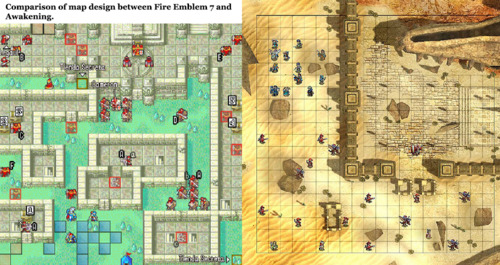
Putting it together and falling apart
Unfortunately, this is also where Awakening fails. Some bring up the game’s casual mode as a detriment to the design, but it is just an option and does not take the place of the traditional permanent death mechanic. Awakening features a world map where you can grind random fights. This gives the player and designers a way out of difficult situations. Players are more inclined to grind experience against random battles when they run into trouble during the main game instead of trying their hardest to outsmart the opposition. This also lets the developers not have to focus as much on fine tuning each encounter, enemy balance, and map design since the player always has a way out. Why design interesting and challenging encounters when you know the player has a safety net they can use to overcome anything? This loose balance of Awakening was incredibly noticeable to me. Even on harder modes like Lunatic and Lunatic+ the game is balanced so poorly that the additional difficulty is no fun.
This lack of balance is not only found in encounter and enemy design but also in the players amount of choices. Reclassing your characters to obtain certain abilities and skills from other classes lets players buff their army even more. No longer do you have to deal with and strategize around your unit composition because now you can just create any unit you like.
But there are more problems than a change to progression. Awakening is lacking in terms of map design, mission objectives, removal of features, and is harmed by the addition of the Pair Up mechanic.
In terms of map design, Awakening suffers from a lack of interesting design and variety. Most maps in the game are big, open plains with minimal or boring design elements. A lot of Fire Emblem’s best moments come from great map design creating bottlenecks in the map that the two sides have to fight over and unfortunately those types of maps are hard to find in Awakening. Fog of War is also another element missing from Awakening. Fog covers the map and each of your units can only reveal a small portion around where they stand. This was used to obscure enemy tactics and positions from the player adding an additional challenge to certain chapters
Mission objectives are also sorely lacking in Awakening. All of the mission objectives are to either “rout the enemy” or “kill the leader”. This is disappointing considering previous games in the series had a wide variety of objectives including defending an area, capturing a spot or multiple spots, escaping a map, and holding out for a certain number of turns.
Perhaps the change that is most damaging to the balance is the Pair Up mechanic. When two units stand next to each other they can pair up into one super powerful unit. This mechanic is incredibly over powered. Depending on the support rank of the two characters, the stat bonuses can be immense, creating god-like units that can solo (duo?) the game. It not only creates broken units, but removes strategic options by taking away one of your units from the field. If pairing up had a downside, the player would have to weigh their options between pairing up and staying separate as equal choices. The mechanic would be fine like that, but the way it was implemented into the game makes it a choice that only has massive rewards for the player for little to no risk. This mechanic stacks the odds in the players' favor even more because enemies cannot take advantage of the Pair Up mechanic. The opposing army has nothing to stop you once you starting rolling through them.
Many of the other aspects of Awakening like marriage, children, and the lackluster story have been topics of debate by Fire Emblem fans ever since Awakening’s release, but they don’t effect the core gameplay mechanics like the aspects discussed above. There is a lot to love about Fire Emblem: Awakening, but I hope Intelligent Systems is aware of the core issues that Awakening had and are working to fix them for the latest installment in the Fire Emblem series.
#Fire Emblem#Awakening#fire emblem awakening#Marth#chrom#lucina#path of radiance#intelligent systems#fire emblem if#ike#robin#fe:a#fe: awakening
40 notes
·
View notes
Text
Top ten games of the 6th generation

1. Super Smash Bros Melee ; Melee is my favorite game of all time. Not only is it the best Smash game, but I consider it the best fighting game ever. It's a game of unfathomable depth. It’s a game of speed, skill, smarts, and most importantly fun. As a competitive player, I've spent years playing this game and learning about its intricacies and I know I've only scratched the surface. This game has had an incredible history with the competitive community and has only becoming stronger with an amazing run from 2012-2015. Melee is beautifully constructed in every aspect: the weight of each character, speed of the game, L-canceling, wavedashing, ledge mechanics, directional influence, etc. It is the epitome of “easy to play, hard to master”. Even all these years later, the highest level players still haven’t reached the skill ceiling. Perfect play might not even be possible with human hands.
But Melee is not just an insanely deep and and fast 1 v 1 game. Melee, unlike its sequels, is able to satisfy both audiences of casual party players and competitors. All the 4-player free for all game modes are there. Even items, which are turned off in competitive play, are balanced significantly better in Melee than Brawl or Smash 4. The single player modes are still the best as well. Classic, Adventure, and Event modes are the trifecta of single player content in Smash. Adventure lets you tour each iconic Nintendo world with any of the fighters, while event gives you specific challenges that you must overcome. These modes have had successors in the other Smash games, but have not been nearly as good as their appearances in Melee.
Melee has the best stages, the best music and the best gameplay in the entire Smash series. It is the best game of the 6th generation and my favorite game ever made.
youtube

2. F-Zero GX ; F-Zero GX much like Melee, is the best entry in its entire genre. I think anyone who has spent enough time with GX will agree that it is the single best racing game ever made. Its notable for its unmatched sense of speed and its difficulty, but those alone wouldn't make for a good game. It is because of the insanely deep control you are given over your F-Zero machines that the difficulty and speed becomes manageable. This game is very hard, yet fair. You are given all the tools you need to succeed and are pushed to learn how to use them if you want to win. With multiple cups, racers, customizable machines and parts and a crazy hard story mode, F-Zero GX is a game you could play for years and never get bored.
youtube

3. Fire Emblem ; I was introduced to Fire Emblem, like most people, through Super Smash Bros Melee. It wasn't until I saw my friend play it on GBA that I decided to give it a try. I’m glad that I did because now Fire Emblem is my favorite RPG franchise ever. This particular entry was the seventh FE game but the first game in the series to be localized for North America (thus the simple title). The timing was great because they chose one of the very best games in the series to bring over to our shores. Fire Emblem is a beautifully paced and designed game. It’s an RPG that isn't as much about leveling up and getting better stats as it is about smart strategy and thoughtful moves. The story is a fun medieval adventure with dragons, magic, and the like, yet each character really brings a color to the world they inhabit. Every character is a unique individual with a personality that you will get attached to. The strategy gameplay is fined tuned to perfection with a limited amount of EXP available throughout the whole game. That means you have to think about which characters you want to grow, which have uses in your strategy and which are falling behind. Fire Emblem forces the player to think about their strategy which then affects the characters relationships and how your party composition ends up. The art is brilliantly clear and colorful with battle animations being some of the most memorable in any RPG. The OST is one of the most memorable in the series. This game was massively influential and played a huge part in defining my taste in games.

4. Metroid Prime ; When moving to 3D gaming, Nintendo was one of the few developers who were able to transitions their franchises from 2D and keep up the high quality. Super Metroid is an incredibly tough act to follow, but skipping the N64 might have been the best thing that happened to this series. Being able to push the Gamecube gave Retro Studios the power they needed to fully realize a world and mechanics that would not be possible on the N64. Metroid Prime is a masterpiece adventure. There are almost too many aspects that elevate this game to greatness to even count. The detail and design of each environment was years ahead of its time. First person platforming actually works and it’s good. The music perfectly matches the mood and sets the atmosphere. These aspects are great, but the game as a whole really is more than the sum of its parts. It may still be unmatched in 3D world design, and that’s a damn good accomplishment.

5. Metal Gear Solid 3 ; Metal Gear Solid 3 is one of the best games I have ever played. This game was Kojima’s peak. He was able to blend and balance the 007-esque espionage story with the alternate history and fantasy elements so well. What makes this experience so memorable is how cohesive it feels. The story informs the gameplay and vice versa. MGS3 is a game that isn’t afraid to let the player fail. It asks the player to think before acting. There is so much detail in every aspect of this game that it is easy to become overwhelmed, but as you traverse the Russian jungles you learn so much. You learn how to trick the guards, how to sneak past traps, lights, guard dogs, and how to escape tricky situations designed with all of those elements. The pacing is very well crafted with slow sneaking sections lasting just long enough to build up the suspense for a big action scene without overstaying their welcome and becoming boring. Even through all the bombast, the crazy story twists, and the fast paced action, it still manages to have one of the most affecting final moments and one of the most beautiful mergers of cut scene and gameplay ever. It’s linear but leaves room for exploration and experimentation. It’s vague and mysterious while giving you the tools to figuring everything out. It is a game that respects the player and asks you return that respect. MGS3 is an unforgettable experience.

6. Mother 3 ; Earthbound is one of my favorite games ever made. But despite waiting and hoping, Mother 3 never came out in North America. I’m a little ashamed it took me so long to play this (I just finished it last month!), but I’m happy that I did. I had been told for years about how Mother 3 is one of the best told stories in gaming, and one of the best games ever. I’m happy to say that I think Mother 3 lived up to that hype. The game itself is a pretty standard turn based RPG, but has a rhythm element to each battle. The music based battle system paired with the rolling health meter creates a tense risk/reward that always feels fair. But Mother 3 isn’t really about the difficulty or intricacies of its game mechanics; it’s really all about the story. While Earthbound is about the meaning of growing up and learning the truths behind the world, Mother 3 is about humanity, innocence, and the distortion of those concepts. Mother 3 is so perfectly written and designed. I’ve seen Mother 3 referred to as the closest games have come to literature, I think that comparison is pretty funny but apt. Nothing is wasted and everything has meaning. I honestly don’t think I could ever do justice to the masterpiece of a story that is Mother 3. It is something to be played, enjoyed, and kept with you forever. Mother 3 may be the most personal and human game I have ever played.

7. Resident Evil 4 ; RE4 is such a perfectly polished and tightly paced game, it’s scary(hehe). It evolved the classic RE tank controls just enough to feel good in the over-the-shoulder view while balancing action, suspense and horror perfectly. The design of each area is unique and interesting both from a story and gameplay perspective, the gunplay is incredibly sharp and responsive, and the enemy encounters are always tense. The culmination of all these aspects lead to one of the greatest survival horror games ever made. Resident Evil 4 is a thrilling game that you won’t ever want to put down.

8. The Legend of Zelda: Twilight Princess ; The choice between Wind Waker and Twilight Princess was tough. Zelda is my favorite franchise and I would place both games as equals on my series tier list. However there are a couple reasons why I chose TP to represent Zelda on this list. Yes, Twilight Princess has a slow and boring opening, but after that the game really comes into its own, Wind Waker starts more quickly but runs into a major roadblock in the back half which is more harmful to the game design in my opinion. Twilight Princess earns its spot on this list because it has arguably the best dungeon designs in the entire Zelda series. Every dungeon does something new even with old and traditional items like the boomerang, which now creates a tornado for Link to use in puzzles, and the iron boots, which allow link to walk on magnetized surfaces while also allowing him to sink to the bottom of bodies of water. Twilight Princess has an incredible OST. Tracks like Midna’s Lament and the new Lost Woods are some of the best in the series. The art as well, specifically in the Twilight Realm, is very good. There is a soft lighting to everything that gives off a very eerie mood and nicely complements the rest of the game. Even though Twilight Princess can be seen as OoT 2, it does enough to really differentiate itself as a sequel and has some of the best designed challenges the series has ever seen.

9. Halo 2 ; Halo 2 marked the start of my experiences with online gaming. It was the first game I ever played online and the game I spent the most time with (until Halo 3 was released). This game was really influential to me. I really cut my teeth on competitive multiplayer with this game and I made many friends through this series. It was a staple when hanging out with friends or just playing online. Halo 2 had amazing maps, amazing gunplay, and some of the best competitive gaming moments ever. Halo 2 lead me to MLG, which was my obsession throughout high school and sparked my interest in competitive gaming. I still think Halo 2 is the best game in the series.

10. Pokémon Ruby/Sapphire ; This particular entry in the Pokémon franchise is really special to me. I put incredible amounts of time into this generation of Pokémon games. This was the last game that really had the feeling of mystery and discovery for me. I was young, and Ruby was the game that all the people I knew talked about. Rumors and speculation were rampant with this title. Rumors like getting the 100th rocket launch and going to the moon to catch Jirachi, secret ways to get the eon ticket and a method to get Deoxys without going to an official event. Hoenn is one of my favorite game worlds and the weather effects, music, and art really brought me in like no other game has. Pokémon Ruby accompanied me on countless family vacations and road trips. It was a world that I never got tired of and it will always hold a special place in my heart.
Honorable Mentions
x. Wind Waker ; Gorgeous, but has weak dungeons and a terrible fetch quest before the end.
x. Super Mario Sunshine ; The last Mario game with incredibly smooth and fast movement.
x. Nocturne ; Incredible RPG, but I haven’t finished it yet!
x. Fire Emblem Path of Radiance ; Possibly a top 3 game in the series. PoR has my favorite story in the series.
x. Devil May Cry 3 ; Dante vs Vergil. It’s possibly the greatest rivalry in gaming and some of the most intense and amazing boss battles ever.
x. Persona 4 ; I played this on Vita, and while it’s fantastic, I just can’t think of it as part of the 6th gen. especially because it was originally released in 2008.
x. Half Life 2 ; Its Half Life 2.
#game of the generation#gamecube#xbox#playstation#ps2#super smash bros#super smash bros melee#pokemon#halo#metal gear solid#resident evil#legend of zelda#twilight princess#mother3#earthbound#fire emblem#metroid#metroid prime
0 notes
Video
youtube
Top Ten Games of 2014
#top ten#goty#game of the year#korra#the legend of korra#super time force#super smash bros#ultra street fighter 4#street fighter#mario kart#donkey kong#donkey kong country returns tropical freeze#bravely default#shovel knight#dark souls#dark souls 2#bayonetta#bayonetta 2
1 note
·
View note
Text
Korra finale review
So Korra…
While I thought these last two episodes were entertaining (cool fights, nice set pieces) I think the finale really drove home the sense of nothingness I’ve felt all season. While book 4 wasn’t “bad” It might be the biggest example of wasted potential yet. Book 4 felt like filler before the end. Book 3 (which I loved) ended on a strong question of “Is the avatar relevant anymore?” and while Book 4 tries to pick up that idea, it quickly stumbles and loses the message. That would have made excellent fodder for a final season but instead we get swept away with poorly written politics and a cardboard cutout villain.
I think a lot of this stems from Kuvira, the worst villain to ever appear in the Avatarverse. Kuvira is one of the most shallow, one dimensional villains ever. Her motivations surprisingly boring and there is no depth to any aspect of the character. She is the evil dictator archetype through and through. I never felt the sense of dread that the other villains imposed on the show (yes even Unalaaq is better) because she is so vanilla. We get almost no backstory on her character until the very end where we get the classic “I’m an orphan and my parents never loved me” line. The finale had her stomping her way through republic city blowing stuff up, but why? What was her end goal? Was she going to a specific location in Republic City? Kuvira’s presence brings up the larger issue of the politics being extremely poorly written but I’m not even going to get into that.
This season started very strong, but Korra’s recovery plotline and Kuvira’s takeover plotline were so drawn out with very little content that the majority of this season felt so slow. I really dislike how we had the whole fanservice in the swamp arc for Korra’s recovery but it ended up not mattering at all. The parallels they were trying to draw between Korra and Kuvira felt so forced. Oh Kuvira is stubborn and rash, and Korra was once stubborn and rash, uh okay I guess, if that’s the best you can come up with. Every plotline felt so underdeveloped.
Then we get to the finale in which lacks any emotional payoff. When I finished ATLA for the first time I said “wow that was one of the best shows I've seen.” When I finished LoK I said “well, alright then.” We didn't get any closure on any of the characters in a meaningful way. In particular I would have liked to see more Mako and Bolin (which is pretty funny because they actually grew on me a lot, especially Mako). Mako might have been one of the worst characters in Korra before, but I thought he worked really well as the down-on-his-luck straight man to Wu’s craziness. The Korrasami ending was cool, but was completely out of nowhere. If this show focused on a few characters the whole time maybe they could have earned that plotline, but because they were spread so thin with a large cast none of the characters felt truly developed. The end felt like just pandering fanservice.
In the end I feel nothing, I liked Korra overall but this finale just brought home the fact the Book 4 was largely a throw away plot with no meaningful addition to the story in the way that the previous three seasons were (even 2, despite how horrible it is, with its portal opening stuff). It was a nothing finale to a nothing season. Avatar is one of my favorite fictional stories and I thought I would be sadder at it ending then I am. As it stands, the ending of Colbert was way more emotional than this.
I guess I’ll put my season rankings here:
ATLA 2 = ATLA 3
LoK 3
ATLA 1
LoK 1
LoK 4
LoK 2
2 notes
·
View notes
Photo
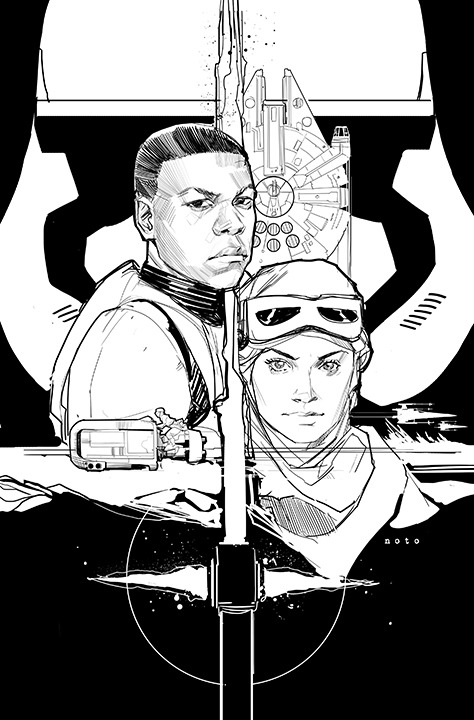
STAR WARS- EPISODE VII: The Force Awakens
I got so excited after watching the trailer, I had to do some art. Felt like 6 y.o. me drawing Luke Skywalker after seeing Ep. 4.
7K notes
·
View notes
Text
Korra book 4 episode 5 'Enemy at the Gates' review
I had a couple thoughts on this last episode.
I think the politics in this show is incredibly poorly written so far. I’ll use a few scenes from this last episode as an example.
Kuvira’s plan is to use Bolin to help persuade Suyin. The problem is that Kuvira undermines her entire plan by going with him to meet Suyin. The whole point of using Bolin is because there is too much personal beef between the two metalbenders to get any proper discussion done. By going to the meeting Bolin’s purpose has been completely thrown away and we get another pointless argument between Kuvira and Suyin. WHY. How could Kuvira, who is supposed to be a smart and powerful leader, not think that this would be incredibly stupid? There is absolutely NO POINT to this plan at all.
I’ll skip over a lot of other dumb stuff, to get to the real problem, Korra and Kuvira’s discussion. Korra first asks Kuvira to back down, but why? She knows only what a couple of children have told her about the situation. I refuse to believe that the air-kids were able to convey the nuance of the situation adequately to Korra. Korra should have asked Kuvira “what’s going on?”, “why are you doing this?”, is there no other way?” etc. Instead we get “please stop because of… reasons.”
There are legitimate arguments for both sides here but this episode took the dumb and shallow path. Kuvira claims to Korra that she is bringing stability to the kingdom and that Zaofu is the last holdout. From what we’ve seen, Kuvira has been helping villages with supplies and keeping bandits away from towns. That seems fair, bringing order and stability to places where there is none. What exactly is unstable with Zaofu? It’s pretty much the beacon of high society and technology in the Earth Kingdom. If anything, it has been the MOST stable place in the entire kingdom for years. This is a completely valid argument that Korra could have used, but didn’t.
When Kuvira responds, Korra goes into a dumb statement about people being mad at her. It’s like Korra forgot the whole reason she was there to begin with. The fact that Kuvira had to “make some tough decisions” does not change the fact that Korra wants her to back down. She has abandoned the purpose of their discussion to feel sad and let Kuvira manipulate her. Kuvira then asks her to go back to Suyin and try to convince her. This is beyond stupid. What is she expecting Korra to say to Suyin?
Korra: “You should let Kuvira take over because she worked hard”
Suyin: “No”
Seriously? Kuvira just looks stupid here. Maybe this scene would have been okay if Kuvira had some sort of message or sentiment that would mean more to Suyin coming from Korra, but she basically used poor writing to buy time.
The amount of pure stupidity in this episode prevented me from enjoying it at all.
1 note
·
View note
